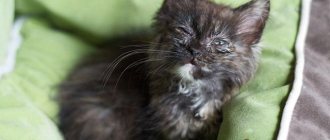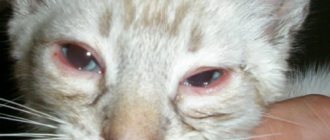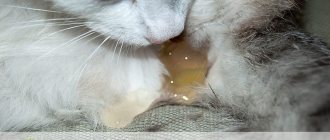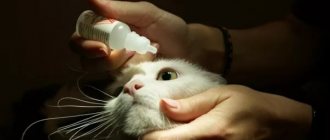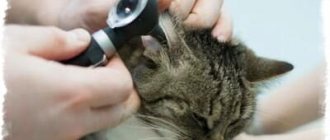Abundant mucous, bloody, purulent and other pathological discharge from the eyes of cats can appear for various reasons. If your pet's visual organ is swollen, crusts have formed, and other unpleasant symptoms have arisen, then you need to immediately show your pet to a veterinarian. If the source of discharge in the corners of the eyes is not identified in time, the cat’s vision may deteriorate or disappear completely.
Diagnostic procedures
Discharge from the eyes of cats of brown color and other shades should not be ignored, since without timely diagnosis and the necessary treatment, there is a high probability of complications and deterioration in the pet’s visual function. As soon as the owners notice that the cat’s eyes are watering, dark discharge has appeared around the visual organs and other unpleasant symptoms, they should contact a veterinarian. To make an accurate diagnosis and clarify the nature and source of pathological exudate, the specialist prescribes a series of laboratory and instrumental examinations. The cat's owner is asked about the animal's diet when purulent discharge or other unpleasant signs of illness occur.
Complex diagnostics includes the following manipulations:
- Schirmer test to determine the quantitative content of tears in a cat;
- measurement of intraocular pressure;
- blood test to identify pathologies of viral and bacterial origin;
- cytological examination of scrapings obtained from the ocular cornea;
- PCR reaction;
- endoscopy of the nasal passages.
If the specialist was unable to determine the source of the cat’s discharge in the eye area and select treatment, then ultrasonography and dacryocystorhinography are additionally performed. In rare cases, an X-ray of the skull is performed.
Discharge from the eyes
The discharge is usually clear or has a brownish tint, accompanied by a reddish/brown coloration of the cat's eyes, and the eyes may also become watery. The reasons for the appearance of discharge can be different: impaired outflow of tears, foreign objects in the eye, epiphora, blepharitis, etc. Discharge can also be a consequence of poor nutrition - for example, mixing natural food with feed or feed from different manufacturers in the diet.
Infrequent discharge from your pet's eyes is normal. But you should still wash your cat's eyes periodically.
Treatment and prevention of eye discharge
In order for the discharge to stop, its cause must be identified and eliminated. To cleanse the eyes, you can rinse with warm clean water, tea, chamomile decoction, saline solution or boric acid solution (add 2 teaspoons to ½ glass of water).
To carry out the rinsing procedure, you may need the help of another person to hold the pet while you drip the solution. Prepare a tampon in advance by twisting cotton wool into a rope. It is better to avoid using cotton swabs, because... they can injure the animal's eye). After soaking the swab in the solution, squeeze it onto the cat's eyeball. If your pet's eyelids are glued together, then the solution is applied directly to their surface: after a while, the eyelids will open, which will allow you to proceed to rinsing the eye. If your cat's eyelashes are stuck together, run a cotton swab over their surface, moving towards the corners of the eyes. If the eyelashes do not fall apart immediately, repeat the procedure until you can rinse the eye itself.
If the discharge appears due to infection, then the cat should be shown to a veterinarian as soon as possible. Rinse your animal's eyes only with a warm solution (not hot, but not cold either). Be careful not to let the dry swab or cloth come into contact with the surface of the eye, as the material may stick to it, causing damage. When washing and wiping your eyes, change swabs as often as possible.
The veterinarian may prescribe eye drops to treat the animal. To instill the medicine, turn your pet's head so that the eyes are looking up. Place your hand with a pipette or cotton swab dipped in liquid 1-2 cm from the cat's eye, and then start dripping 1-2 drops.
The eye ointment should be squeezed into the corner of the eye, slightly pulling the lower eyelid. Before doing this, it is better to warm the ointment to room temperature so that it gets into the eye more easily.
You shouldn’t wait until your pet starts to have discharge from the eyes - rinse them as a preventative measure. It is especially important to care for the eyes of a cat that is often outdoors, as dust particles and fingers can get into them.
What to do and how to treat?
Before visiting the doctor, you can wipe your pet’s eyes with a herbal decoction.
If the owners notice that the cat’s eyes are festering and other alarming symptoms are recorded, then they should not delay a visit to the veterinarian. At home, it is possible to treat the visual organs with decoctions based on chamomile, calendula and other medicinal herbs that have antimicrobial and antiseptic effects. After conducting a comprehensive examination and identifying the root cause of the problem, the pet is prescribed medications.
You should not apply any eye drops to cats for pus at your own discretion, since there is a high probability of worsening the disease and developing complications. In most cases, it is possible to cope with unpleasant symptoms in a pet with the help of the following ophthalmic medications:
- "Iris";
- "Leopard";
- "Diamond Eyes";
- "Levomycetin".
For a speedy recovery of your pet and elimination of pathological exudate, you need to know how to properly apply eye drops to a cat. To do this, the pet's head is fixed so that the visual organs are directed upward. It is better to perform the manipulation together to ensure reliable fixation of the cat. The pipette must be kept at a distance of 2 centimeters from the eye, so that in case of sudden movement it does not damage the mucous membrane of the eye. Treatment is carried out until the animal recovers completely, until the discharge completely stops appearing.
Purulent discharge: causes and treatment
The main reasons for the appearance of purulent discharge:
Conjunctivitis is an inflammation of the conjunctiva, or mucous membrane, eyelids and eyeball.
There are several varieties of this disease due to the cause of its occurrence (bacteria, viruses, allergens), the nature of the symptoms and treatment methods. Allergic conjunctivitis. The disease can occur in acute or chronic form. It occurs due to contact with the eye of any substance to which a person has an allergic reaction. It can also be triggered by a decrease in general immunity, a violation of metabolic processes in the body. It manifests itself as a burning sensation, fatigue, which increases in the evening. There is not much purulent discharge; it is noticeable mainly in the morning. As the acute process develops, the discharge intensifies, tearing and severe redness appear.
Infectious conjunctivitis. Caused by infectious agents such as bacteria or viruses, it is often associated with the common cold. Infection occurs mainly through the traditional airborne route for viruses, through dirty hands or through the use of contaminated objects (towels, pillows, toys, etc.). It often occurs in an acute form with severe symptoms: copious purulent discharge, lacrimation, pain. The disease may develop against the background of damage to the upper respiratory tract - adenoviral conjunctivitis. Then headaches, high fever and swollen lymph nodes join other manifestations.
Herpetic. It is provoked by the herpes simplex virus. It occurs more often in children and is characterized by a one-sided process, a prolonged sluggish course, and the appearance of blisters on the skin of the eyes. Symptoms may be more or less severe, depending on the course of the disease. In the acute form, there is a burning sensation and pain in the eyes, lacrimation and purulent discharge.
Paratrachoma. This conjunctivitis occurs due to damage to the organs of vision by chlamydia. The disease develops after sexual contact with a person with a genital infection, and is less often transmitted through contaminated water in swimming pools. The incubation period ranges from 2 to 19 days. Usually accompanied by redness, swelling and suppuration. Most often, with this disease, symptoms are observed in only one eye.
Trachoma. Chlamydia is also a cause, but in this case it affects only the organs of vision. Manifestations of the disease are the same as with paratrachoma. Follicles form on the cornea, which leave scars.
Blepharitis is a disease characterized by inflammation of the eyelids at the outer or inner edge. It can be caused by exposure to demodex mites, Staphylococcus aureus or allergens. Manifested by itching, swelling, redness. In its acute form, the disease is accompanied by the formation of ulcers.
Keratitis - occurs due to inflammation of the cornea of the eye. Viruses, bacteria, and fungi can cause this disease. Also among the possible causes are mechanical or chemical damage to the eye, the action of allergens. With keratitis, there is pain, decreased vision, photophobia, increased lacrimation, scarring and inflammation of the conjunctiva may occur.
Dacryocystitis - most often newborn children and women are susceptible to this disease. Obstruction of the lacrimal canal occurs due to thickening of its walls. In the lacrimal sac, fluid accumulates and stagnates and a bacterial pathogenic environment develops. Because of this process, redness and swelling of the eyelids are observed, and purulent discharge is formed.
Stye is one of the most common eye diseases. This inflammatory process is caused by a bacterial infection. An abscess forms on the eyelid, swelling and redness. Sometimes there may be an increase in body temperature and enlarged lymph nodes.
How to cure conjunctivitis in a child?
Treatment for conjunctivitis depends on the child's symptoms and type of disease.
For the bacterial form of the disease, antibiotics in the form of eye ointments or drops are indicated. Every 2-3 hours, to prevent the formation of a purulent crust, the eyes should be washed with special solutions. It is better to instill drops during the day, and apply ointment to the eyes at night, because it relieves itching, pain, helps you sleep and prevents eyelids from sticking together.
In case of allergic conjunctivitis, first of all, you need to protect the child from the allergen. Antihistamine and anti-allergenic drops are prescribed. The course of treatment is usually 2-4 weeks. Source: L.D. Ksenzova Treatment of allergic conjunctivitis in children // Issues of modern pediatrics, 2008, vol. 7, no. 5, pp. 135-140
Viral conjunctivitis does not require special therapy. Within a few days, the child’s body copes with it on its own. It is important during this period to prevent infection - maintain personal hygiene, do not scratch your eyes, and wash your face twice a day.
Disease prevention
Basic preventive measures:
- disinfect the room in which the child is located;
- observe the rules of personal hygiene;
- strengthen immunity;
- Avoid contact with anyone who has conjunctivitis.
Do not delay going to the doctor if you notice signs of this disease in your child. The earlier treatment is started, the lower the risk of complications. Make an appointment with a SM-Clinic specialist.
Sources:
- N.N. Arestova, L.A. Katargina, E.V. Yani. Conjunctivitis and dacryocystitis in children: clinical characteristics, modern treatment options // Russian Pediatric Ophthalmology, 2016, No. 11(4), pp. 200-206.
- L.D. Ksenzova. Treatment of allergic conjunctivitis in children // Issues of modern pediatrics, 2008, vol. 7, no. 5, pp. 135-140.
Ageev Vladimir Sergeevich Clinic
Author of the article
Ageev Vladimir Sergeevich
Candidate of Medical Sciences
Specialty: ophthalmologist
Experience: 15 years
The information in this article is provided for reference purposes and does not replace advice from a qualified professional. Don't self-medicate! At the first signs of illness, you should consult a doctor.
Nasal discharge
A cat's nose cleans the inhaled air of dust and other contaminants. But in addition to air, the animal can inhale pathogenic bacteria and viruses. The nose filters them out, preventing them from entering the body. Dust and microbes settle on the mucous membrane, forming dark thin crusts. They are released through the nose while washing. Such discharge is not a sign of illness, but a normal phenomenon for the animal.
A cat can also inhale a foreign body - an insect, a small bone, a thread, etc. In this case, he begins to sneeze, as a result of which the foreign particle comes out of the nose on its own. If the foreign object does not come out, under no circumstances try to remove it yourself (you can seriously damage the mucous membrane), but show the cat to a veterinarian.
Copious nasal discharge, accompanied by sneezing and heavy breathing, indicates a serious illness in the cat, because pathogens of incurable diseases - leukemia and peritonitis - can enter the animal’s body through the nose. Only timely vaccinations can protect a pet from them.
Treatment of scleritis
The etiology (causes), localization, severity, and characteristics of the course of the disease determine the therapeutic strategy. Thus, a viral infection is stopped through immunostimulation and immunomodulation, a bacterial infection - with antibiotics, allergic inflammation - with antihistamines.
Glucocorticoid drugs, corticosteroid drops and ointments are widely used locally, and sometimes non-steroidal anti-inflammatory drugs are used orally. During the recovery stage, physiotherapeutic procedures are almost always prescribed.
In the most serious cases, for example, with abscesses and/or the risk of perforation of the sclera, ophthalmic surgery is indicated, incl. for scleral tissue transplantation.
Reasons for the appearance of a child
The inflammatory process on the conjunctiva can be provoked by:
- Viruses, including adenovirus and herpes. The disease lasts no more than 10 days, but can be complicated by bacterial infection.
- Infections – gonococci, streptococci, Pseudomonas aeruginosa, staphylococcus, fungi. The disease is severe, on average 2 weeks.
- A fungus that affects children with immunodeficiency.
- Chlamydia is an intermediate microorganism between viruses and bacteria.
- Improper hygiene, eye injuries with subsequent infection.
- Allergy – intolerance to certain substances, medications, products.
- Long-term inflammatory diseases of the nose, eyes, ears - tonsillitis, sinusitis, rhinitis.
Breed Features
Another variant of the norm for increased mucus secretion in cats is determined by the breed. This feature occurs in cats with a flattened muzzle. This characteristic is accompanied by disruption of the nasolacrimal duct and nasopharynx. As a result, the outflow of fluid worsens and excessive accumulation occurs in the organs of vision.
Prominent representatives of these breeds are:
- "Persians";
- "British";
- Exocote;
- Scottish Fold (Scottish Fold cat);
- Manul;
- Himalayan cat.
In addition to increased mucus accumulation, these cats may experience problems associated with nasopharyngeal congestion. Snoring, frequent snorting and noisy eating are not uncommon manifestations in these breeds. Owners should carefully care for their pets and prevent the development of a pathological condition. Regular visits to the veterinarian will be helpful for this.
Diagnostic methods
Before treating conjunctivitis, it is necessary to identify what type of conjunctivitis is present in the child. To do this, first a history of the disease is collected, and then laboratory and ophthalmological examinations are prescribed:
- biomicroscopy of the eye;
- a smear from the conjunctiva followed by cytological examination in the laboratory;
- analysis for the level of IgE and eosinophils in the blood;
- skin allergy tests;
- tests for worms and dysbacteriosis;
- microscopic examination of tear fluid;
- bacteriological examination of discharged pus;
- scraping for enterobiasis.
If an allergic type of disease is suspected, the child is advised to consult an allergist, who will prescribe additional tests.


